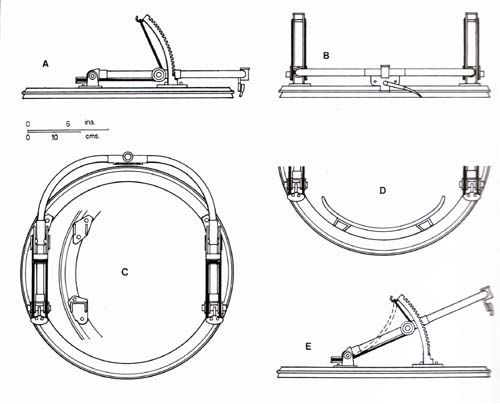This ol' cat has flown the AH Bristol Fighter and found it particularly wanting in one crucial respect - the field of fire of the Lewis gun wielded by the Poor Bloody Observer (PBO) is inadequate when compared to the real thing.
The PBO's Lewis (or Lewises, if he was using the double-gun 'Huntley and Palmer' set-up) was mounted on the Scarff No.2 ring (known officially in the RFC as the No.3 Mk.II Barbette). The AH model's gun is modelled as if it's fitted rigidly to the yoke instead of on the spigot that allowed movement in both azimuth and elevation
independent of the yoke.
Here's a diagram of the Scarff No.2 ring:

A, B and C show the ring construction; D shows the backrest (not always fitted); E shows the position of the 'Sandow' [aerolastic or 'bungee'] in stretched (active) and released (inactive) position. The cord was supposed to be released when the ring was not in use otherwise it deteriorated. When twin guns were mounted thicker cord had to be used.
Next, here's a picture of a Bristol's Scarff ring:

Note that the bracket for the Lewis gun is pointing downwards; it was also capable of being pointed upwards to an equal degree, and swivelled to the left and right. The range of movement of the Lewis gun was only limited by the need for the PBO to get behind it to sight it. He would raise or lower the yoke to the required setting by squeezing the lever underneath; a set of rods inside the yoke caused teeth to engage the quadrants, so holding the yoke in the position required when the lever was released. If he lowered the yoke to its lowest setting and swivelled the ring to left or right, he could fire downwards to the rear and sides as well as upwards.
Here's a picture of the twin-Lewis setup on a RAF RE8:

See the angle of the guns are high relative to the Scarff ring yoke; they're pointing higher than is possible with the AH offering. The PBO couldn't move them much to the left or right at such an angle without fouling the yoke but he'd have no trouble swivelling a single Lewis, or the pair if he was standing up and firing downwards.
The pictures and diagram were taken from Early Aircraft Armament: The Aeroplane and the Gun up to 1918 by Harry Woodman; 1989, Arms and Armour Press, London, ISBN 0-85368-990-3.
I'm no programmer so I can't advise HT how to model it - but I would like a proper chance to shoot at the Huns - or my own wings or tail off - while using a proper Scarff ring No.2.
